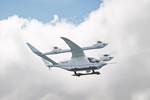Aurora reveals latest SPRINT X-Plane design concept
An Aurora and Boeing team advances its high-speed, vertical lift concept to the preliminary design phase, which features three lift fans, a more refined composite exterior and an uncrewed cockpit.
Rendering of embedded lift fans with integrated covers transitioning between vertical and forward flight. Source | Aurora Flight Sciences
Aurora Flight Sciences (Bridgeport, W.Va.), a Boeing Company, recently completed conceptual design review for the Defense Advanced Research Projects Agency’s (DARPA) high-speed, vertical lift X-plane, and has been selected to continue development of a preliminary design review. The program, called Speed and Runway Independent Technologies (SPRINT), “aims to design, build and fly an X-plane to demonstrate the key technologies and integrated concepts that enable a transformational combination of aircraft speed and runway independence.”
Aurora’s concept is a low-drag, fan-in-wing demonstrator that integrates a blended wing body platform, combining the agility of vertical takeoff and landing (VTOL) with unprecedented speed. The team’s approach seeks to set the program on the path to successful flight and demonstrate game-changing capability for air mobility and special operations forces (SOF) missions.
New renderings of the fan-in-wing (FIW) demonstrator reveal three lift fans; a more refined composite exterior; and an uncrewed cockpit. The choice of three lift fans reflects the team’s strategy to simplify the demonstrator and streamline its path to flight test. The FIW technology could be scaled to four or more lift fans to meet future aircraft requirements, and it could unlock opportunities for a future family of systems. Similarly, while an uncrewed demonstrator offers benefits in testing and risk reduction, the FIW technology would be fully transferrable to traditional aircraft with crews.
Aurora’s concept is designed to meet or exceed the challenging program objectives that DARPA set for the program. For example, the blended wing body platform is capable of 450-knot cruise speed, and the embedded lift fans with integrated covers enable a smooth transition from vertical to horizontal flight. The design also leverages existing engine solutions, shortening development risk and timelines. In addition to VTOL, the aircraft is capable of short takeoff and vertical landing (STOVL), super short takeoff and landing (SSTOL) and conventional takeoff and landing (CTOL).
“Aurora and Boeing bring relevant expertise in blended-wing-body platforms, high-speed VTOL configurations and military aircraft development,” says Larry Wirsing, vice president of aircraft development at Aurora Flight Sciences. “The DARPA SPRINT program is an exciting opportunity to continue our history of advancing technology demonstrator programs that enable new capabilities for the U.S. military.”
Aurora and Boeing’s Vertical Lift teams are combining more than 30 years of experience in novel VTOL platforms with a proven technology maturation process. The team estimates completion of their preliminary design review for the SPRINT program in approximately 12 months, with the goal of first flight in 36 months.
Related Content
-
3D-printed CFRP tools for serial production of composite landing flaps
GKN Aerospace Munich and CEAD develop printed tooling with short and continuous fiber that reduces cost and increases sustainability for composites production.
-
Optimized approach to predict delamination failure in CFRTP structures
ARRK Engineering and Mitsui Chemicals improved delamination prediction accuracy to help optimize absorbed energy/failure load for an overmolded TAFNEX CF/PP UD tape bumper beam.
-
Active core molding: A new way to make composite parts
Koridion expandable material is combined with induction-heated molds to make high-quality, complex-shaped parts in minutes with 40% less material and 90% less energy, unlocking new possibilities in design and production.
















